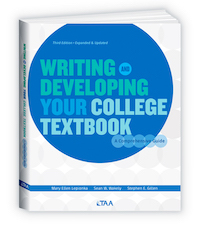Writing and Developing Your College Textbook: A Comprehensive Guide, 3e | Table of Contents
 Introduction Introduction
Part I: Understanding the Higher Education Textbook Publishing Industry
by Sean W. Wakely
Chapter 1. The Evolving Higher Education Textbook Publishing Industry
The Publishing Landscape
Industry Trends
Publisher Profiles
Sample: A Sampling of College Textbook Publishers and Commercial Publishing Alternatives
Recommended Resources
Chapter 2. How College Textbooks Are Published
Publishers’ Lists
The Publishing Cycle
Getting Started
Template: Marketing Strategies
Recommended Resources
Chapter 3. How to Capture Publishers’ Interest
Understanding Signing Goals
Building Publisher Relationships
Contacting Acquisitions Editors
Preparing and Submitting Your Proposal
Understanding How an Acquisitions Editor Evaluates a Proposal
Sample: Guidelines for Preparing a Proposal, Annotated Outline, and Cover Letter
Recommended Resources
Part II: Negotiating Your Textbook Publishing Contract
by Stephen E. Gillen
Chapter 4. Negotiate Your Contract
Steps to Getting an Offer
Establishing a Positive Relationship
Before Negotiating Your Agreement
Recommended Resources
Part III: Writing and Developing Your College Textbook
by Mary Ellen Lepionka
Chapter 5. Why Your Textbook Needs Development
Development Planning
Negotiating for Development Help
A Development Editor’s Role
Levels of Development
Who Does the Development Editor Work For?
Establishing a Good Working Relationship
Doing Your Own Development
Sample: Sample Competition Grid
Sample: Guidelines and Questions for Peer Reviews
Recommended Resources
Chapter 6. Write To Reach Your True Audience
Reflect On Your Mission
Identify Your Real Reader
Avoid Undeclared Bias
Write to Reading Level
Write for Clarity
Aim for Good Expository Writing
Sample: Wordiness Elimination Guide
Recommended Resources
Chapter 7. Establish an Effective Authorial Voice
Your Voice
Your Attitude Toward Your Subject
Your Philosophical and Political Orientations
Your Tone
Your Reader
Sample: Some “Bad Voice” Archetypes
Recommended Resources
Chapter 8. Why You Need Learning Objectives
Reflect on Your Instructional Goals
Determine How Learning Objectives Differ From Goals
Determine How Learning Objectives Guide Chapter Development
Apply Findings from Educational Psychology
Use Learning Objectives to Express Conditions of Performance
Construct Chapters from Learning Objectives
Sample: Learning Objectives in Relation to Bloom’s Taxonomy: An Application
Template: Template for Writing Learning Objectives and Using Them to Plan Content
Recommended Resources
Chapter 9. Why Heading Structure Matters
Consider Your Organization
Develop Parts and Chapters
Learn the Art of Chunking
Write Good Titles
Develop Your TOC
Determine Levels of Heading
Craft Headings
Determine Topical Development
Determine the Role of Headings in Textbook Packages
Sample: Planning for Topical Development: A Sample
Template: A Template for Developing Text Sections
Recommended Resources
Chapter 10. Your Pedagogy and Apparatus
Principles of Direct and Indirect Instruction
Students as Active Learners
New Pedagogical Models
Chapter Openers
Chapter Closers
Internal Pedagogical Devices
Template: Developing Your Pedagogy Plan
Template: Planning Your Chapter Apparatus
Recommended Resources
Chapter 11. Develop Successful Feature Strands
Functions of Feature Strands
Case Studies
Profiles
Debates
Primary Source Excerpts
Models or How-Tos
Reflections and Rating Forms
Critical Thinking Exercises
Thematic Boxes
Supplement Tie-Ins
Pedagogy Pitfalls
Your Pedagogy Plan
Template: Planning Your Feature Strands
Template: Your Chapter-by-Chapter Ideas for Features
Sample: Outline of a Sample Pedagogy Plan for an Undergraduate Textbook in Archaeology
Recommended Resources
Chapter 12. Make Drafting and Revising Easier
Prepare Your Manuscript
Submit a Complete Manuscript
Commit to Consistency
Develop Drafting Checklists and Manage Resources
Monitor Topical Balance
Draft to Length
Draft to Schedule
Develop Your Own Drafting Calendar
Template: Mechanics and Style Checklist
Template: Apparatus and Pedagogy Checklist
Sample: Sample Pages from a Drafting Calendar
Recommended Resources
Chapter 13. Attend to Permissions
Managing Source Citations
Understanding Copyright Law
Permissioning Internet Sources
Permissioning Photos and Art
Managing the Cost of Permissions
Developing a Permissions Log and Tracking Requests
Requesting and Handling Grants of Permission
Sample: Sample Permissions Log
Template: Permissions Log Template
Recommended Resources
Chapter 14. Attend to Presentation
Alternative Text
The Importance of Presentation
Graphic Organizers
Figures and Tables
The Craft of Visualizing Information and Creating Original Figures
Photo Program Planning
The Art of Writing Captions
Sample: Ways of Visualizing Information
Recommended Resources
Chapter 15. Putting It All Together
Working with a Copy Editor
Learning Disaster Control Guidelines for Length
Determining Whether Your Book “Has Legs”
Authoring Textbooks in the Digital Age
Recommended Resources
References
Glossary
Index
|